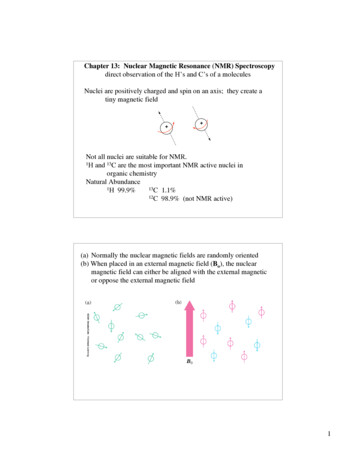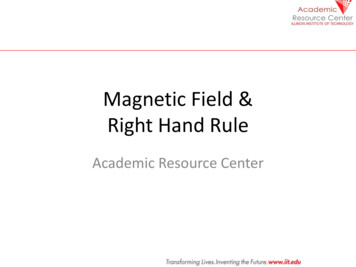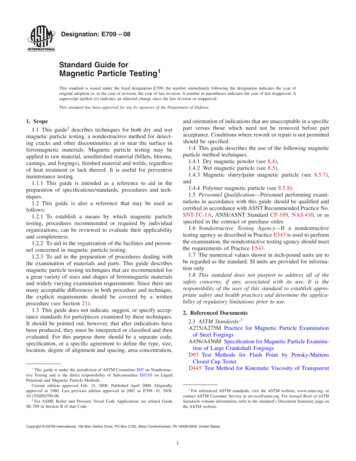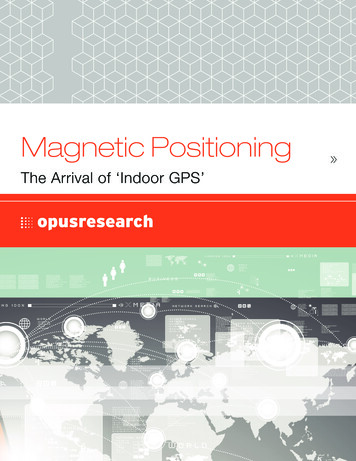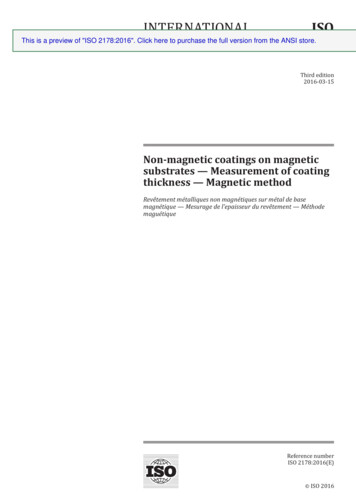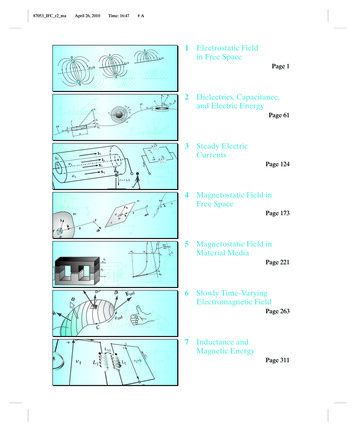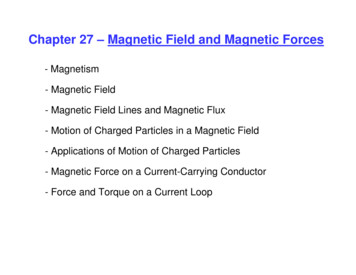
Transcription
Chapter 27 – Magnetic Field and Magnetic Forces- Magnetism- Magnetic Field- Magnetic Field Lines and Magnetic Flux- Motion of Charged Particles in a Magnetic Field- Applications of Motion of Charged Particles- Magnetic Force on a Current-Carrying Conductor- Force and Torque on a Current Loop
1) A moving charge or collection of moving charges (e.g. electric current)produces a magnetic field. (Chap. 28).2) A second current or charge responds to the magnetic field andexperiences a magnetic force. (Chap. 27).1. MagnetismPermanent magnets: exert forces on each other as well as on unmagnetizedFe pieces.- The needle of a compass is a piece of magnetized Fe.- If a bar-shaped permanent magnet is free to rotate, one end points north(north pole of magnet).- An object that contains Fe is not by itself magnetized, it can be attracted byeither the north or south pole of permanent magnet.- A bar magnet sets up a magnetic field in the space around it and a secondbody responds to that field. A compass needle tends to align with themagnetic field at the needle’s position.
1. Magnetism- Magnets exert forces on each other just like charges. You can drawmagnetic field lines just like you drew electric field lines.- Magnetic north and south pole’s behavior is not unlike electric charges.For magnets, like poles repel and opposite poles attract.- A permanent magnet will attract ametal like iron with either the north orsouth pole.
Magnetic poles about our planet
Magnetic declination / magnetic variation: the Earth’s magnetic axis is notparallel to its geographic axis (axis of rotation) a compass readingdeviates from geographic north.Magnetic inclination: the magnetic field is not horizontal at most of earth’ssurface, its angle up or down. The magnetic field is vertical at magneticpoles.Magnetic Poles versus Electric Charge- We observed monopoles inelectricity. A ( ) or (-) alone wasstable, and field lines could bedrawn around it.- Magnetscannotexistasmonopoles. If you break a barmagnet between N and S poles,you get two smaller magnets, eachwith its own N and S pole.
-In 1820, Oersted ran experiments withconducting wires run near a sensitivecompass. The orientation of the wireand the direction of the flow bothmoved the compass needle.- Ampere / Faraday / Henry movinga magnet near a conducting loop caninduce a current.- The magnetic forces between twobodies are due to the interactionbetween moving electrons in theatoms.- Inside a magnetized body (permanentmagnet) there is a coordinated motionof certain atomic electrons. Not true forunmagnetized objects.
2. Magnetic FieldElectric field:1) A distribution of electric charge at rest creates an electric field E in thesurrounding space.2) The electric field exerts a force FE q E on any other charges inpresence of that field.Magnetic field:1) A moving charge or current creates a magnetic field in the surroundingspace (in addition to E).2) The magnetic field exerts a force Fm on any other moving charge orcurrent present in that field.- The magnetic field is a vector field vector quantity associated witheach point in space.Fm q v B q v B sin ϕ- Fm is always perpendicular to B and v. Fm qv B
2. Magnetic Field- The moving charge interacts with the fixed magnet. The force betweenthem is at a maximum when the velocity of the charge is perpendicular tothe magnetic field.Interaction of magnetic forceand charge
Right Hand RulePositive charge moving in magnetic field direction of force follows right hand ruleF q vB Negative charge F directioncontrary to right hand rule.Units: 1 Tesla 1 N s / C m 1 N/A m1 Gauss 10-4 T
Right Hand RuleIf charged particle moves in region where both, E and B are present: F q( E v B)
Measuring Magnetic Fields with Test ChargesEx: electron beam in a cathode X-ray tube.- In general, if a magnetic field (B) is present, the electron beam is deflected.However this is not true if the beam is // to B (φ 0, π F 0 nodeflection).Electron q 0 F has contrarydirection to righthand ruleNo deflection F 0 v // BDeflection F 0 F v, B
3. Magnetic Field Lines and Magnetic Flux- Magnetic field lines may be traced from Ntoward S (analogous to the electric field lines).- At each point they are tangent to magneticfield vector.- The more densely packed the field lines, thestronger the field at a point.- Field lines never intersect.- The field lines point in the same direction as a compass (from N toward S).- Magnetic field lines are not “lines of force”.
- Magnetic field lines have no ends they continue through the interior ofthe magnet.
Magnetic Flux and Gauss’s Law for Magnetism Φ B B dA B cos ϕ dA B dA- Magnetic flux is a scalar quantity.- If B is uniform: Φ B B A BA cos ϕUnits: 1 Weber (1 Wb 1 T m2 1 N m / A)- Difference with respect to electric flux the total magnetic flux througha closed surface is always zero. This is because there is no isolatedmagnetic charge (“monopole”) that can be enclosed by the Gaussiansurface. Φ B B dA 0dΦ BB dA - The magnetic field is equal to the flux per unit area across an area at rightangles to the magnetic field magnetic flux density.
4. Motion of Charged Particles in a Magnetic Field- Magnetic force perpendicular to v it cannot change themagnitude of the velocity, only its direction. Fm qv B- F does not have a component parallel to particle’s motion cannot do work.- Motion of a charged particle under the action of a magnetic field alone isalways motion with constant speed.- Magnitudes of F and v are constant (v perp. B) uniformcircular motion.v2F q v B mRmvRadius of circular orbit in magnetic R qBfield: particle counter-clockwise rotation.- particle clockwise rotation.
Angular speed: ω v/R ω vqBmv qBmCyclotron frequency: f ω/2π- If v is not perpendicular to B v// (parallel to B) constant because F// 0 particle moves in a helix. (R same as before, with v v ).A charged particle will move in a planeperpendicular to the magnetic field.
5. Applications of Motion of Charged ParticlesVelocity selector- Particles of a specific speed can be selected fromthe beam using an arrangement of E and B fields.- Fm (magnetic) for charge towards right (q v B).- FE (electric) for charge to left (q E).- Fnet 0 if Fm FE -qE q v B 0 v E/B- Only particles with speed E/B can pass throughwithout being deflected by the fields.Source of chargedparticles
Thomson’s e/m Experiment E K U 0 0.5 m v2 U e VeE2 m 2VB 2E2eVv Bme/m does not depend on the cathode material or residualgas on tube particles in the beam (electrons) are acommon constituent of all matter.
Mass Spectrometer- Using the same concept as Thompson,Bainbridge was able to construct a device thatwould only allow one mass in flight to reachthe detector.- Velocity selector filters particles with v E/B.After this, in the region of B’ particles with m2 m1 travel with radius (R2 R1).mvR q B'
6. Magnetic Force on a Current-Carrying Conductor Fm qvd B Force on one chargeFm qvd B- Total force:Fm (nAl )(qvd B )n number of charges per unit volumeA l volumeFm (nqvd )( A)(lB ) ( JA)(lB ) IlB(B wire)In general:F IlB IlB sin ϕMagnetic force on a straight wire segment: F Il BMagnetic force on an infinitesimal wire section: dF Idl B
- Current is not a vector. The direction of the current flow is given by dl, not I.dl is tangent to the conductor. F Il B
7. Force and Torque on a Current Loop- The net force on a current loop in a uniform magnetic field is zero.Right wire of length “a” F I a B(B l)Left wire of length “b” F’ I b B sin (90º - φ)F’ I b B cos φFnet F – F F’ - F’ 0- Net torque 0 (general). τ r Fτ r F sin α r F rF τ F ' r F sin 0 0τ F F (b / 2) sin ϕ(B forms 90º-φ angle with l)
τ total τ F ' τ F ' τ F τ F 0 0 2(b / 2) F sin ϕτ total ( IBa)(b sin ϕ ) IBA sin ϕTorque on a current loopA abTorque is zero, φ 0ºφ is angle between a vectorperpendicular to loop and B
τ total IBA sin ϕMagnetic dipole moment: µ IA Electric dipole moment: p qdDirection: perpendicular to plane of loop(direction of loop’s vector area right handrule)τ total µB sin ϕ τ p E Magnetic torque: τ µ BElectric torque:Potential Energy for a Magnetic Dipole:Potential Energy for an ElectricDipole: U µ B µB cos ϕ U p E
Magnetic Torque: Loops and CoilsIf these loops all carry equal current “I” in sameclockwise sense, F and torque on the sidesof two adjacent loops cancel, and only forcesand torques around boundary 0.Solenoidτ NIBA sin ϕN number of turnsφ is angle between axis of solenoid and BMax. torque: solenoid axis B.Torque rotates solenoid to position where itsaxis is parallel to B.
Magnetic Dipole in a Non-Uniform Magnetic Field- Net force on a current loop in a non-uniform field is not zero. dF Idl BRadial force components cancel eachOther Fnet to right.N SIf polarity of magnet changes Fnet to left.N S
Magnetic Dipole and How Magnets WorkA solenoid and a magnet orients themselveswith axis parallel to field.Electron analogy: “spinning ball of charge” circulation of charge around spin axissimilar to current loop electron has netmagnetic moment.- In Fe atom, large number of electron magneticmoments align to each other non-zeroatomic magnetic moment.- In unmagnetized Fe piece no overallalignment of µ of atoms total µ 0.- Iron bar magnet magnetic moments of manyatoms are parallel total µ 0.- A bar magnet tends to align to B, so that linefrom S to N is in direction of B.
- South and North poles represent tail and head of magnet’s dipolemoment, µ.How can a magnet attract an unmagnetized Fe object?1) Atomic magnetic moments of Fe try to align to B of bar magnet Feacquires net magnetic dipole moment // B.2) Non-Uniform B attracts magnetic dipole.The magnetic dipole produced on nail isequivalent to current loop (I direction righthand rule) net magnetic force on nail isattractive (a) or (b) unmagnetized Fe objectis attracted to either pole of magnet.S NN S
- If a bar-shaped permanent magnet is free to rotate, one end points north (north pole of magnet). - An object that contains Fe is not by itself magnetized, it can be attracted by either the north or south pole of permanent magnet. - A bar magnet sets up a magnetic field in the space around it and a second body responds to that field.

